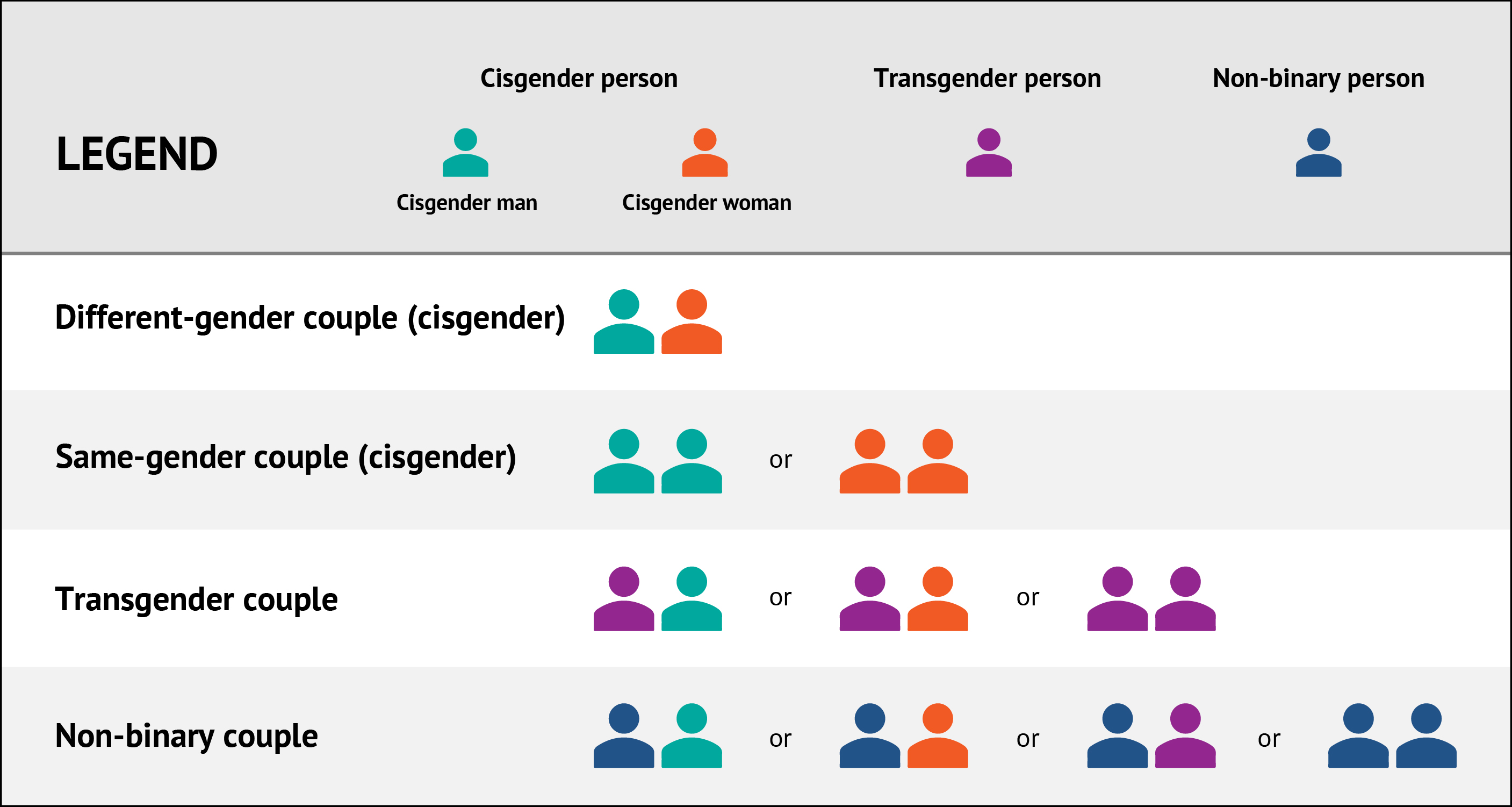Gender diversity status of couples: New information in the 2021 Census
Start of text box 1
Gender diversity status of couple refers to whether both members of a couple are cisgender, or whether at least one member is transgender or non-binary. Among cisgender couples, a distinction can be made between those composed of two persons of different genders (a different-gender couple) or those composed of two persons of the same gender (a same-gender couple).
Different-gender couple (cisgender) refers to couple families in which members are cisgender and of different genders (one man and one woman).
Same-gender couple (cisgender) refers to couple families in which members are cisgender and of the same gender (two men or two women).
Transgender couple refers to couple families in which at least one member is transgender and neither member is non-binary.
Non-binary couple refers to couple families in which at least one member is non-binary.
Couples may not necessarily self-identify using these terms.
End of text box 1
On July 13, 2022, Statistics Canada will disseminate census information on the gender diversity status of couples for the first time.
For the 2021 Census, the precision of ‘at birth’ was added to the sex question on the census, and a new question on gender was included.
These changes allow all persons living in Canada—including transgender and non-binary individuals—to self-identify through the census. This represents another step in Statistics Canada’s continuing efforts to better reflect societal changes and produce statistical information on diverse population groups.
The terminology used to describe families and couples continues to evolve. New concepts for the 2021 Census related to the gender diversity status of couples were developed following consultations with experts (Figure 1).
Figure 1. Gender diversity status of couples: A visual guide

Description for Figure 1
This graphic, titled “Gender diversity status of couples: A visual guide” illustrates the gender diversity status of couple families with the aid of images of non-gendered persons of different colours.
It includes a legend describing the colours used to distinguish persons according to their gender diversity status.
The category “Cisgender person” includes the sub-category “Cisgender man,” represented by a turquoise person, and the sub-category “Cisgender woman,” represented by an orange person.
The category “Transgender person” is represented by a purple person.
The category “Non-binary person” is represented by a blue person.
Four distinct configurations are displayed: Different-gender couple (cisgender), Same-gender couple (cisgender), Transgender couple and Non-binary couple.
The different-gender couple (cisgender) is represented by a group of two persons situated side by side composed of one cisgender man, which is illustrated by a turquoise person, and one cisgender woman, illustrated by an orange person.
The same-gender couple (cisgender) is represented by two groups of two persons situated side by side. The first group is composed of two cisgender men, illustrated by two turquoise persons, and the second group is composed of two cisgender women, illustrated by two orange persons.
The transgender couple is represented by three groups of two persons situated side by side. The first group is composed of one transgender person, illustrated by a purple person, and a cisgender man, illustrated by a turquoise person; the second group is composed of a transgender person, illustrated by a purple person, and a cisgender woman, illustrated by an orange person; the third group is composed of two transgender persons, illustrated by two purple persons.
The non-binary couple is represented by four groups of two persons situated side by side. The first group is composed of one non-binary person, illustrated by a blue person, and a cisgender man, illustrated by a turquoise person; the second group is composed of a non-binary person, illustrated by a blue person, and a cisgender woman, illustrated by an orange person; the third group is composed of one non-binary person, illustrated by a blue person, and one transgender person, illustrated by a purple person; the fourth group is composed of two non-binary persons, illustrated by two blue persons.
Data aggregation of couples will sometimes be necessary to protect the confidentiality of responses provided. Please see 2021 Census population thresholds for detailed gender for more information.
Start of text box 2
For more information
- Families, Households and Marital Status Reference Guide, Census of Population, 2021
- Gender diversity status of couple family variable
- Gender diversity status of marriage or common-law union variable
- Filling the gaps: Information on gender in the 2021 Census
- Canada is the first country to provide census data on transgender and non-binary people
- Age, Sex at Birth and Gender Reference Guide, Census of Population, 2021
- 2021 Census: Sex at birth and gender – the whole picture (video)
- Balancing the Protection of Confidentiality with the Needs for Disaggregated Census Data
- Gender and sex at birth variables
End of text box 2
- Date modified: